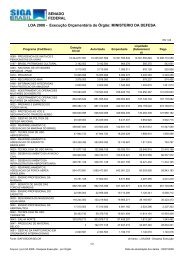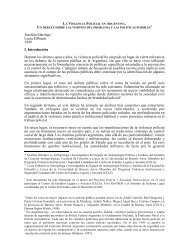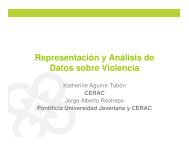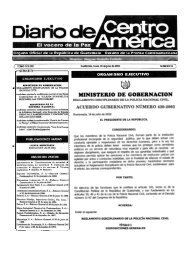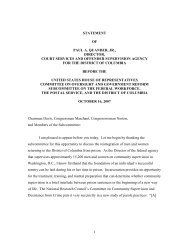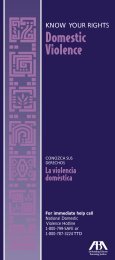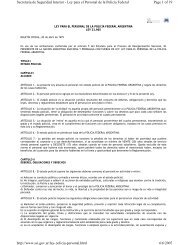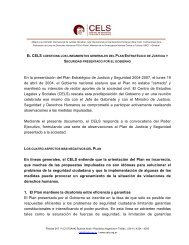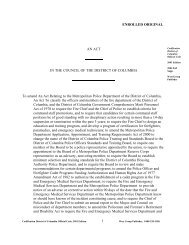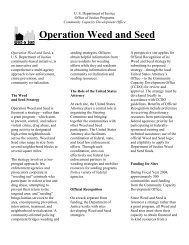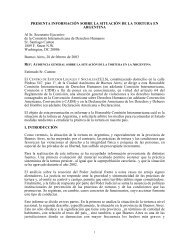Venezuela: The Life and Times of the Party System - Political ...
Venezuela: The Life and Times of the Party System - Political ...
Venezuela: The Life and Times of the Party System - Political ...
You also want an ePaper? Increase the reach of your titles
YUMPU automatically turns print PDFs into web optimized ePapers that Google loves.
<strong>of</strong> this reform was to increase <strong>the</strong> powers <strong>of</strong> <strong>the</strong> voters vis-à-vis <strong>the</strong> party organizations (Molina<br />
1991b). In all, 269 mayors were chosen throughout <strong>the</strong> country. Of <strong>the</strong>se, AD won 151, COPEI<br />
105, MAS 10, Causa R 2, with an independent group <strong>of</strong> voters from <strong>the</strong> state <strong>of</strong> Falcón winning 1<br />
(Table 9). In <strong>the</strong>se elections, 38.4 percent <strong>of</strong> <strong>the</strong> c<strong>and</strong>idates ran under <strong>the</strong> banner <strong>of</strong> a multiparty<br />
coalition. Alliance politics were decisive in only two cases for AD, but for COPEI <strong>the</strong> coalition<br />
option was critical to victory in twenty-five races, seventeen <strong>of</strong> which saw alliances between<br />
COPEI <strong>and</strong> MAS. 1 Even though <strong>the</strong> government party once again proved victorious in <strong>the</strong>se<br />
contests, alliance politics within <strong>the</strong> opposition functioned smoothly <strong>and</strong> demonstrated <strong>the</strong>ir<br />
capacity to generate support, thus undoubtedly streng<strong>the</strong>ning <strong>the</strong> practice <strong>of</strong> interparty accords in<br />
<strong>the</strong> future.<br />
In <strong>the</strong> December 1989 elections for municipal councilors, 24.5 percent were chosen by<br />
preference voting <strong>and</strong> 75.5 percent through <strong>the</strong> traditional party-list method. (Only 14 percent <strong>of</strong><br />
voters made use <strong>of</strong> <strong>the</strong> new electoral option.) Of <strong>the</strong> 481 councilors elected by nominal voting,<br />
41.2 percent gained <strong>of</strong>fice through <strong>the</strong> effects <strong>of</strong> preference voting (10 percent <strong>of</strong> <strong>the</strong> total number<br />
<strong>of</strong> councilors elected). 2 Though underutilized by <strong>the</strong> electorate, <strong>the</strong> capacity <strong>of</strong> nominal voting to<br />
modify <strong>the</strong> positions <strong>of</strong> c<strong>and</strong>idates on party lists altered <strong>the</strong> final outcome significantly.<br />
Both voter abstention <strong>and</strong> <strong>the</strong> underutilization <strong>of</strong> preference voting are cause for some<br />
reflection on <strong>the</strong> implications <strong>of</strong> recent electoral reforms. Why did <strong>the</strong>se elections, <strong>and</strong> <strong>the</strong> new<br />
electoral system on which <strong>the</strong>y are based, not awaken <strong>the</strong> ‘civic enthusiasm’ hoped for? Were<br />
such expectations justified in <strong>the</strong> first place? 3 Numerous opinion polls have shown that <strong>the</strong><br />
public was not well informed about <strong>the</strong> issues <strong>and</strong> had no clear image <strong>of</strong> what was at stake in<br />
<strong>the</strong>se political <strong>and</strong> electoral reforms. 4 Fur<strong>the</strong>rmore, when one considers that <strong>the</strong> last elections<br />
took place a mere 10 months after <strong>the</strong> violence <strong>of</strong> 27-F (Kornblith 1989), it is perhaps even more<br />
remarkable that <strong>the</strong> government party was able to get an electoral majority in <strong>the</strong> first place, <strong>and</strong><br />
that abstention did not climb higher still. <strong>The</strong> lack <strong>of</strong> adequate publicity about <strong>the</strong> new system,<br />
combined with <strong>the</strong> overall atmosphere <strong>of</strong> social unrest, political decay, <strong>and</strong> economic decline,<br />
suggests that expectations <strong>of</strong> greater electoral participation <strong>and</strong> interest in <strong>the</strong> December<br />
elections were unfounded.<br />
1 Data are from CSE (1989c). See also Carrasquero <strong>and</strong> Welsch (1989c).<br />
2 Data are from CSE (1990a). According to Molina, <strong>the</strong> number <strong>of</strong> voters using <strong>the</strong> preference<br />
voting system reached 30 percent <strong>and</strong> 24 percent <strong>of</strong> municipal councilors were elected by<br />
preference voting (see Molina 1991b, 225 ff.).<br />
3 For an argument that <strong>the</strong> question <strong>of</strong> preference voting was given exaggerated importance in<br />
debates over electoral reform, see Guzmán (1989a).<br />
4 A review <strong>of</strong> press coverage between May <strong>and</strong> November 1988 shows that electoral reform<br />
was not an issue <strong>of</strong> great importance, <strong>and</strong> fur<strong>the</strong>r, that it faded as <strong>the</strong> campaign got underway.<br />
This is consistent with <strong>the</strong> low level <strong>of</strong> information in <strong>the</strong> general public about issues <strong>of</strong> electoral<br />
reform. See CSE (1990c; also 1989b).



